Learning how to use a snatch block, also know as a pulley block, is an essential vehicle recovery skill for off-roading and overlanding. A snatch block is a heavy-duty pulley inside a metal casing that is used with a winch to recover a stuck vehicle.
Snatch blocks can serve two purposes in off-road vehicle recovery: 1) increasing the pulling force of a winch and 2) redirecting the force of the winch cable to pull the stuck vehicle from a variety of angles. This versatility extends the capabilities of your winch, allowing for recovery of heavier or seriously stuck vehicles or rescues in challenging circumstances.
This article and the video below are focused on undetstanding and using snatch blocks. For guidance on choosing the right snatch block for your vehicle and winch set up, see our guide to the best snatch blocks for overlanding and off-roading.
This article is intended for informational purposes only and is not a replacement for formal, hands-on training. Off-road recovery of vehicles can be dangerous. Check out your local off-roading club or other training programs for basic instruction on off-road recovery techniques.
Modern snatch blocks used for vehicle recovery in overlanding and off-roading are fairly simple devices, comprising a pulley (also known as a sheave) sandwiched between two metal side plates and held together with a pin. The side plates can be twisted apart to wrap the winch line around the pulley. When the side plates are lined up, the two holes form an eye that is used to attach the snatch block to an anchor or vehicle using shackles and (in some cases) tree savers or other recovery straps.
How to Use a Snatch BlockSnatch Blocks can be used in a number of different scenarios and configurations in off-road recovery. Here, we’ll cover several common techniques. The physics of using winch snatch blocks can be a bit counterintuitive, but we’ll try to explain where it’s easy to make errors in these common scenarios.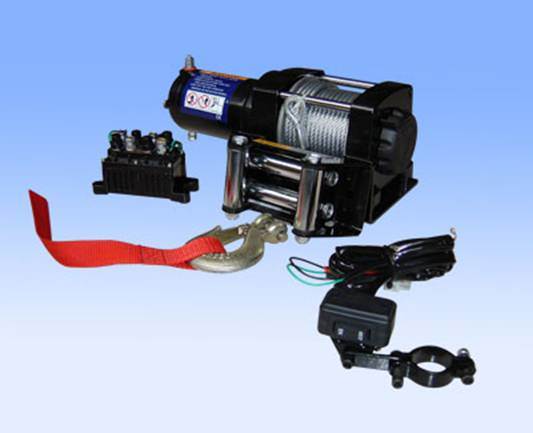
A snatch block bolsters the pulling force of the winch by providing mechanical advantage, a function of passing the winch cable around the snatch block’s pulley and back to the vehicle. In the case below (Technique #1), the snatch block is used to roughly double the pulling force exerted by the winch in a self-recovery situation where a tree is used as an anchor. It’s not quite double the force, because of friction added by the snatch block itself.
Configuration #1The winch cable extends from the winch on the vehicle through the snatch block and back to a secure recovery point on the vehicle. While the snatch block reduces the pulling force required by the winch in this configuration, note that the anchor (the tree in this case) is still bearing the entire load of the vehicle. This is one of the most common recovery techniques with a winch and snatch block. You could anchor directly to the tree-saver with a recovery shackle instead of a snatch block, but using the snatch block has the advantage of reducing the strain on your winch.
Here’s a tricky nuance to the physics. If the end of the winch cable attached back to a tree instead of the vehicle, as pictured below, the snatch block provides no mechanical advantage. Since the line is static between the trees, the winch would be required to pull the full load of the vehicle. This is basically the same as attaching directly to the tree-saver with no snatch block involved. Don’t do this.
Another common technique involves two vehicles, depicted below, where one vehicle is stuck and the other uses its winch to rescue it. The snatch block is connected to the stuck vehicle with a shackle at a sturdy recovery point. The winch cable runs from the recovery vehicle through the shackle on the stuck vehicle, then connects back to the recovery vehicle with a shackle at a recovery point.
Configuration #2Multiple snatch blocks can be used in a winching and pulley configuration to further increase the pulling power of the winch. Such is the case below, where a second snatch block is attached to the rescue vehicle and the cable passes through it and back to the stuck vehicle.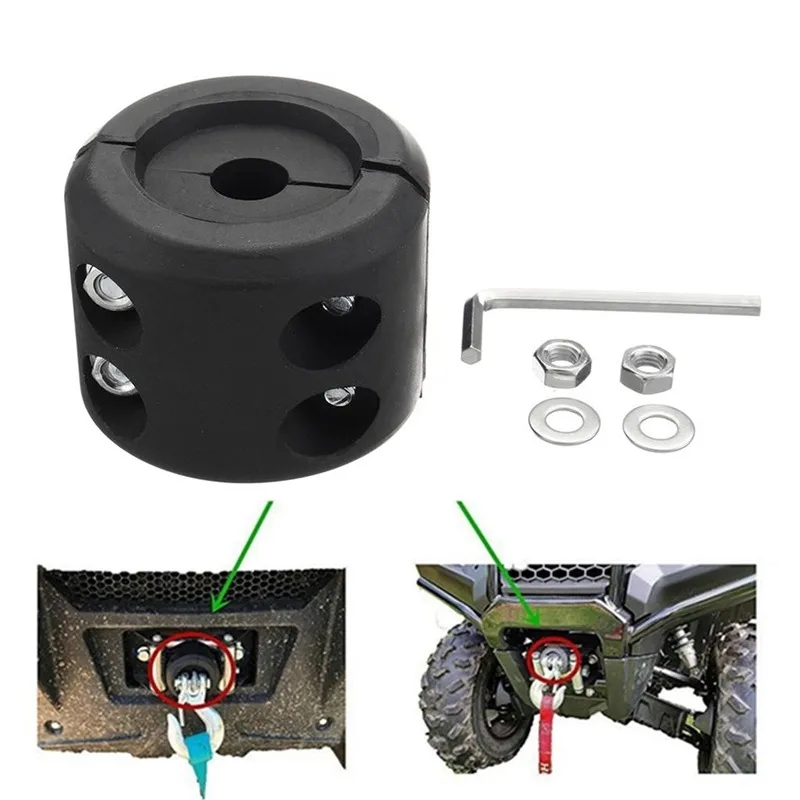 This roughly triples the pulling power of the winch.Configuration #3
This roughly triples the pulling power of the winch.Configuration #3
This technique can be helpful when the stuck vehicle’s weight exceeds the capacity of the winch or extra force is needed to pull a very stuck vehicle loose.
Using a Snatch Block to Redirect the Winch CableSometimes it is difficult or impossible to use a rescue vehicle winch to pull directly on a stuck vehicle. In such cases, a snatch block can redirect the force coming from the rescue vehicle to pull the stuck vehicle in the ideal direction. Configuration #4
In the situation depicted above, a tree is used as an anchor so that the rescue vehicle can exert pulling force on the stuck vehicle at a 90-degree angle. In this winching configuration, the snatch block is attached to a tree saver strap with a shackle to prevent damage to the tree. In place of the tree, another large object, could be used, such as a secure boulder. In this case, the snatch block doesn’t reduce the force required by the winch to pull the stuck vehicle – there is no mechanical advantage.
As we explained above, you should always use a tree saver to connect your winch line to a tree or rock to prevent damage to both your anchor and your winch line.
When you are using a snatch block to gain a mechanical advantage or redirect the winch line, use a shackle to connect the snatch block to the tree saver. Thread the winch line around the snatch block sheave before connecting it to the shackle.
Only use rated shackles, the manufacture lists the working load limit (WLL) of the shackle. On metal shackles, the WLL on rated will be embossed on the side. If you are using a synthetic shackle, make sure you know its load limit.
The working load limit is the maximum weight that a particular piece of rigging should be used to handle under normal conditions. The breaking strength rating (different from the WLL) is the weight at which a shackle can be expected to fail. The breaking strength is typically three times the WLL.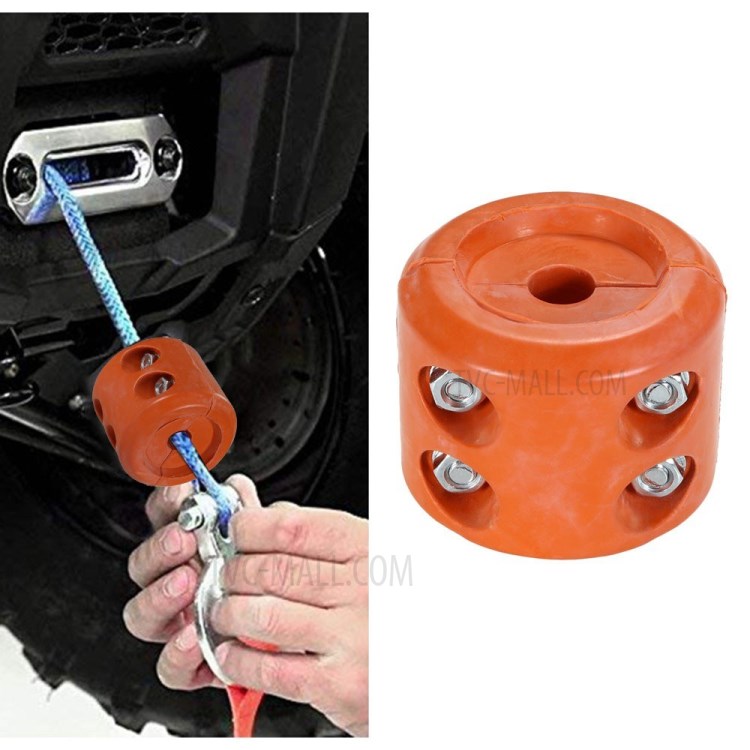
Don’t sideload your D-ring shackle (see image), as this is not how it is designed to be used and weakens it.
Also, make sure your shackle pin is screwed all the way end. It only needs to be lightly hand tightened but should be all the way in.
Don’t do this.A snatch block allows you to multiple the pulling power of a winch by providing mechanical advantage. If used in the correct winching pulley configuration, a single winch can nearly double a winch’s pulling power. Winch configurations that use two or three pulleys (snatch blocks) can triple or quadruple the pulling power, when set up correctly.
There are a number of companies that make snatch blocks for off-roading and overlanding. A few to consider when buying a snatch block are Warn, Rhino USA, Rugged Ridge, Smittybilt, and GearAmerica. For more info, check out our guide to different snatch blocks on the market.
Many snatch blocks can be used with synthetic cables. Ideally, a synthetic winch line should be used with a 8:1 sheave diameter, meaning the diameter of the pulley (sheave) should be 8 times the thickness of the rope. Use snatch blocks where the groove in the sheave where the line sits is U-shaped and not V-shaped, as a V-shaped grove will pinch the line, putting it under unnecessary stress. Check that the grove is free of burrs, which can snag and damage the rope.
ReferencesFour-Wheeler’s Bible, 2nd Edition by Jim Allen.
Off-Road Driving Manual by Vince Cobley & Dave Phillips
Today’s ATVs and UTVs are tremendous machines. They are more powerful, nimble, and technologically advanced than ever before. But sometimes they still need a little help. I’ve covered plenty of valuable ATV aftermarket upgrades, parts, and accessories in the past. And if you own an ATV or UTV, you likely have a few essential items that never leave your rig. Most folks will have a flat tire repair kit and a small tool kit on board, but another incredibly valuable tool to have is a snatch block (or two).
And if you own an ATV or UTV, you likely have a few essential items that never leave your rig. Most folks will have a flat tire repair kit and a small tool kit on board, but another incredibly valuable tool to have is a snatch block (or two).
A basic snatch block should have a simple pulley and a hook, which can be hooked onto an anchor point. In this case, the pulley should be used with your winch rope or cable. The pulley can pop apart and close back on the winch rope, so the rope runs through the pulley. A 2-ton (4,000-pound) rated snatch block is usually affordable, and small enough to fit in the tool storage compartments of many ATVs and UTVs. It’s a tool that might not always see regular use, but when you need it, you’ll be very glad to have it.
If you already have a winch on your ATV or UTV (and you should), you know how useful it is. A snatch block can maximize that usefulness in two major ways.
 Tyler Freel
Tyler FreelFirst, the pulley of the snatch block can be used to enhance the pulling power of your winch. You might be stuck in a mud hole, or need to drag a big bull moose out of a pond. Either way, sometimes the direct pulling power of your winch just isn’t enough. And, if you run your winch too hard without proper rest cycles, you can risk damaging it.
Sometimes it’s handy to be able to double your pulling power, and a single snatch block can handle that. To do this, make sure you are close enough to run your winch out to the object you’re pulling on and back to the machine. For example: If you have 50 feet of rope or cable, you’ll want to be less than 25 feet away so you don’t spool your winch. Next, you’ll need some rope or a strap to loop around your anchor or the thing you’re trying to extract. This could be a tree, an elk or moose, a truck, or even another ATV or UTV.
Loop your winch rope or cable through the pulley, hook the snatch block to the anchor loops you just made, then snap your winch hook back onto a tow ring on your machine. Now, when you wind in your winch, it will pull you (or what you’re towing) at only half the speed, but double the force. If you are trying to pull another ATV out or move an object and it’s dragging you forward, you can sometimes use a tow-strap or rope to tie the rear of your machine off to a tree so that you can’t be pulled forward. In some cases, you can do damage to the frame or anchor points of your machine by doing this, so be careful. But also, desperate times call for desperate measures, and if it’s a matter of getting out of the mud and back home, you’ll have to do what needs to be done and make repairs later.
Now, when you wind in your winch, it will pull you (or what you’re towing) at only half the speed, but double the force. If you are trying to pull another ATV out or move an object and it’s dragging you forward, you can sometimes use a tow-strap or rope to tie the rear of your machine off to a tree so that you can’t be pulled forward. In some cases, you can do damage to the frame or anchor points of your machine by doing this, so be careful. But also, desperate times call for desperate measures, and if it’s a matter of getting out of the mud and back home, you’ll have to do what needs to be done and make repairs later.
Read Next: 5 of the Best Aftermarket Tires for Your ATV
More often than not, you don’t need to double-over winch lines to obtain sufficient pulling force. Between the winch itself, and power applied with a little bit of throttle, you’ll have plenty of juice for most of your needs. However, many tasks can be aided simply by redirecting the force of your winch.
Typically, you will only be able to use your winch or a tow rope to pull in a direction that goes directly back to your machine. Not with a snatch block. If you need a more advantageous angle to pull from, you can simply use a strap or rope to hook the pulley onto a tree or some sort of anchor, run your winch rope through it, and attach to what you’re pulling. This won’t increase your pulling power, but having a better angle can often come in very handy.
While hanging moose meat in camp this year, we had a mishap with our pole, and the lashings began to slip. We had all the meat from the moose hanging, so rather than take it all down, we tied a snatch block above the sagging end of the meat pole, ran the winch rope through, and used it to lift that end of the pole straight up and secure it.
On a sturdy branch, you could easily lift an animal like a deer for skinning and dressing, or even another ATV or your own quad in lieu of a jack for fixing a tire or replacing an axle. If your need to extract yourself or a buddy, it can help give you an upward pulling angle to overcome an obstacle, rather than just pulling parallel with the ground.
If your need to extract yourself or a buddy, it can help give you an upward pulling angle to overcome an obstacle, rather than just pulling parallel with the ground.
Setting a snatch block up can take a bit of time, but you won’t regret having one or two in your tool kit. Their usefulness is only limited by your imagination.
This is the happiness of any jeeper: getting stuck "by no means want" and getting out with the help of another SUV, tractor or tree. But how exactly do you get out? To do this, there should always be something in the arsenal: a winch, a tow rope, a set of shackles, and so on ... We figure it out together, which will be really useful when going off-road and using winches.
There is such a popular expression: “Whatever the SUV, it will always get stuck!”. Partly it is true: without the use of additional means of self-rescue, the passage of fords, muddy mud, sand ambushes and other off-road “charms” are often not possible. However, when using winches, almost all such obstacles become only temporary, interesting barrier. But for winches, there are many different accessories: only cables several types! And how to figure it all out if you are a beginner or not quite an experienced jeeper? Let's tell now!
However, when using winches, almost all such obstacles become only temporary, interesting barrier. But for winches, there are many different accessories: only cables several types! And how to figure it all out if you are a beginner or not quite an experienced jeeper? Let's tell now!
In automotive practice, the word "cable" refers to something that can reliably and flexibly connect a car to a car when towing or wrap around something (tree, stone) when screwing, transmit the reported force and withstand heavy loads. They are called simply by function, and which The "cable" in cross section and what it is made of is secondary in the conversation. The towing cable will be called both the actual round steel cable and the synthetic sling in the form of a tape. Wherein no one will call it a towing tape and will do the right thing, because it has taken root - “towing cable”. So, if you read “rope”, and in the photo there is a flat line, remember that we are talking about the intended purpose of the equipment. It is the issues of the appointment of cables that we will now analyze. The winch cable is designed to rescue a car off-road with the help of an automobile winches. One end is attached to the winch drum, the other is attached to any fixed object or another car.
It is the issues of the appointment of cables that we will now analyze. The winch cable is designed to rescue a car off-road with the help of an automobile winches. One end is attached to the winch drum, the other is attached to any fixed object or another car.
In the process of winding the cable onto the drum, the pulled out car moves towards the anchor (tree, another car, etc.). Winch cable, real in form factor cable: a long braided product made of steel or synthetic threads. Steel and synthetic cables differ in material, weight, comfort of work, resistance to external factors, etc. The choice depends on the operating conditions and personal preferences of the owner. For example, for winter trips, it is recommended to use steel cables, but it is necessary to work with them in thick gloves - so as not to injure your hands on the "fragments" of thin steel threads. But synthetic cables are less traumatic, but are “afraid” of excessive moisture - therefore, after each use, they must be dry thoroughly.
The winch cable must be able to support the declared weight and not stretch during operation. Otherwise If a tensioned cable breaks, it can cause injury to bystanders or seriously damage the car. Strong stretching of the cable will lead to a decrease in its efficiency.
Now that you understand the terminology, it's time to decide which cable is best to use for their goals. The choice, in fact, is small: either a steel (aka iron) cable, or a synthetic one.
IRON CABLE does not require attention, it is quite durable, but inconvenient and traumatic. Wire burrs can injure hands, and when broken the danger of mutilation reaches, without exaggeration, lethal proportions. Therefore, the use of a cable arrester is mandatory (the weight is hung on the cable approximately in the middle, and in the event of a gust, it folds in half, and does not fly anywhere).
SYNTHETIC ROPE is much more pleasant to work with, plus it does not sink in water, which is also convenient. Another important advantage is low weight. For light ATVs and UTV is very important in general, and especially in competitions (in almost all disciplines, traction mechanisms are allowed on ATVs), and for full-size SUVs this is also an important factor. Here every extra kilogram is very disturbing. Again - "synthetics" are much safer than steel, but still you should not touch the stretched "rope", you should not stand right next to it in the process of running. It is also better to work with thick gloves (for iron, this goes without saying). So you will avoid the appearance of corns on the palms. And it must be remembered that after mud baths such a cable must be washed and dried well. Do not leave it for a long time under the snow, rain, scorching sun.
Another important advantage is low weight. For light ATVs and UTV is very important in general, and especially in competitions (in almost all disciplines, traction mechanisms are allowed on ATVs), and for full-size SUVs this is also an important factor. Here every extra kilogram is very disturbing. Again - "synthetics" are much safer than steel, but still you should not touch the stretched "rope", you should not stand right next to it in the process of running. It is also better to work with thick gloves (for iron, this goes without saying). So you will avoid the appearance of corns on the palms. And it must be remembered that after mud baths such a cable must be washed and dried well. Do not leave it for a long time under the snow, rain, scorching sun.
WINCH CABLE EXTENSION allows you to reach a distant tree or car when the standard cable the winch is missing. The extension must meet the same requirements as the winch cable used. That is, withstand the declared weight and not stretch during operation. Winch cable extensions are manufactured from a piece of the same steel or synthetic cable that is used for the winch or from flat slings. A priority choice depends on the purposes and conditions of operation and storage. It is important that the winch cable extension must have loops at the ends for fastening.
Winch cable extensions are manufactured from a piece of the same steel or synthetic cable that is used for the winch or from flat slings. A priority choice depends on the purposes and conditions of operation and storage. It is important that the winch cable extension must have loops at the ends for fastening.
STRING is used to protect tree bark during use winches.
Use of bark protection slings at least 75 mm is a prerequisite for participation in off-road competitions and championships.
The use of a bark protection sling protects the winch's synthetic rope from premature wear. Just for this accessory, the term “sling” is more suitable, since the “skin guard” must be as wide as possible to perform its functions. At its length often does not exceed one and a half to two meters. Sometimes it is also called a "skin-protective harness", since it is in this use that its function as a webbing around the tape is very clear. The properties of the bark protection sling are similar to the winch cable - it must withstand sufficient weight and do not stretch when working. Loops for fastening are made at the ends of the bark protection sling.
Loops for fastening are made at the ends of the bark protection sling.
TOW LINE (also called tow line) can be made with soft loops at the ends or with metal hooks. Depending on this, the type of its attachment to the towing eyes changes. or hitch. The main task of the tow rope is withstand the declared mass of the towed vehicle, taking into account periodic sharp jerks when the load increases significantly. Additionally, the tow rope must withstand the aggressive environment. - friction on asphalt during sagging, etc.
The towing cable can be used as an extension for the winch cable, provided that its “capacity” is equal to or greater than the permitted load winch cable. However, the short length of the cable limits its use in this capacity. The towing rope can also be used as a slings, if it is made in the form of a tape of sufficient width. To reduce the impact on the bark of the tree the cable can be wound in several turns. The main thing is to remember that the free ends of the cable, fixed to winch hook must have the same length. The tow rope must not be used to pull another vehicle with a jerk. Towing The cable is not intended for this purpose and may damage the vehicle's towing eyes or break.
The tow rope must not be used to pull another vehicle with a jerk. Towing The cable is not intended for this purpose and may damage the vehicle's towing eyes or break.
DYNAMIC SLING has several different names: dynamic rope, snatch rope, jerk sling, dynamics. All these names apply to accessories produced in various types, but having the same purpose. A dynamic sling or jerk cable is the most complex and expensive accessory. Special weaving and the materials used allow it to smoothly stretch under load, and then return to its original position. Almost like a rubber band in slow motion. The quality and performance of such slings depends on the quality of materials and workmanship. The main purpose of a dynamic sling is to rescue a stuck car using a jerk from acceleration. The property of "dynamics" to stretch and shrink allows you to make the jerk soft and effectively apply the force of the jerk. Like the rest of the cables, the dynamics also has towing weight limitations. However, if for the towing cable the excess of the "carrying capacity" of the cable will be a plus, then a large excess the weight to break of the dynamic sling over the weight of the towed vehicle will reduce the efficiency of its work. Dynamic sling is good and more suitable for towing a car. However, when towing with the help of “dynamics”, the sling can be damaged due to friction on the asphalt, and subsequently break during a jerk and be dangerous. Plus, you can damage an expensive accessory while towing. for use as a bark protection sling. The property of dynamics to stretch will make inefficient and dangerous to use it as such.
However, if for the towing cable the excess of the "carrying capacity" of the cable will be a plus, then a large excess the weight to break of the dynamic sling over the weight of the towed vehicle will reduce the efficiency of its work. Dynamic sling is good and more suitable for towing a car. However, when towing with the help of “dynamics”, the sling can be damaged due to friction on the asphalt, and subsequently break during a jerk and be dangerous. Plus, you can damage an expensive accessory while towing. for use as a bark protection sling. The property of dynamics to stretch will make inefficient and dangerous to use it as such.
should scare you - all this will only help make towing a stuck car even more efficient.
HOOK is an integral part of any winch. It is with the help of it that the cable is hooked to fixing technology. Hooks must have high strength: they bear the maximum load when towing and lodging.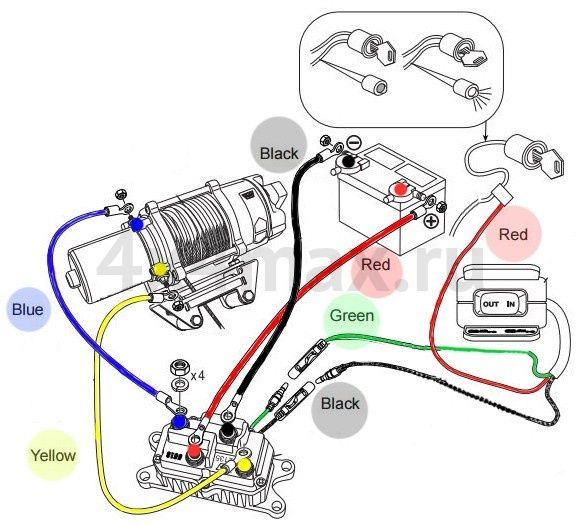 Hooks redBTR are made of high strength alloy steel and meet all the requirements for them.
Hooks redBTR are made of high strength alloy steel and meet all the requirements for them.
POLYSPAST (reinforcement unit) is a lifting device designed to gain strength, as well as change direction of force or thrust. The use of a chain hoist increases the traction force, but reduces the pulling speed. If you use more than one block, but several, then each additional block allows you to double the traction force applied.
The use of a chain hoist reduces the load on the cable and winch by half. Thanks to this, the electric motor works faster and requires less power to operate. By applying the amplification unit using long cables, you can not beware of motor overheating. Winch reinforcement blocks redBTR are made of high quality steel, have differences in size and maximum permissible loads. Are applied with any types of winches.
Shackle is a shackle, which is a connecting element. There are also other names: earlobe, earring, check, shakle bracket, shaklo etc. It is used as a reliable detachable fastener for fixing and connecting towing, dynamic, corrosion protection cables, cable winches and other elements. It can also be an adapter between several cables. Includes brace and locking device in the form of a screw or a finger. They are divided according to the material of manufacture, shape, load capacity and coating used. Metal shackles U-shaped forms are more often used in construction and loading and unloading operations. For off-road, it is customary to use call omega-shaped shackles made of reinforced steel. Due to their shape, they are easier to attach to power bumpers, cables, slings and rack jacks.
It is used as a reliable detachable fastener for fixing and connecting towing, dynamic, corrosion protection cables, cable winches and other elements. It can also be an adapter between several cables. Includes brace and locking device in the form of a screw or a finger. They are divided according to the material of manufacture, shape, load capacity and coating used. Metal shackles U-shaped forms are more often used in construction and loading and unloading operations. For off-road, it is customary to use call omega-shaped shackles made of reinforced steel. Due to their shape, they are easier to attach to power bumpers, cables, slings and rack jacks.
Shackles are available in various finishes: galvanized or resistant paint, treatment with anti-corrosion solutions, etc. The size of the shackle also matters, less for ATVs, more for SUVs, and the more off-road vehicle, the larger shuckle is needed. Most shackles are made of metal, but also Shackles are also made from soft materials.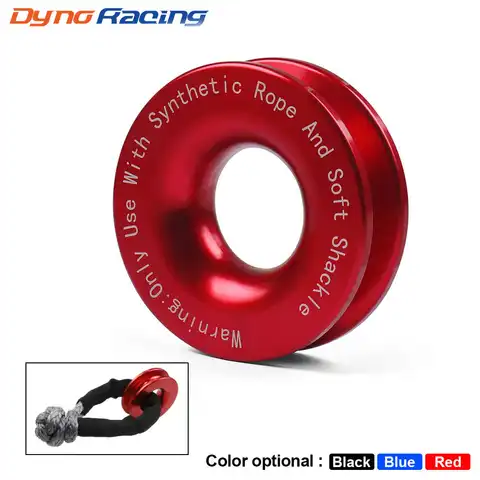 They are called SOFT SHUCKLES. Their distinctive feature in that they can only be used with synthetic ropes and can withstand heavy loads. Their speed advantage use when there is no need to constantly unscrew the locking screw. Soft shackles can be used for quick fixation, they do not sink in water and are quite light in weight. Usually made from nylon.
They are called SOFT SHUCKLES. Their distinctive feature in that they can only be used with synthetic ropes and can withstand heavy loads. Their speed advantage use when there is no need to constantly unscrew the locking screw. Soft shackles can be used for quick fixation, they do not sink in water and are quite light in weight. Usually made from nylon.
And another option is SHACKLE EYE . It is a replacement for the usual hook winches and different more safe and reliable application. Ordinary winch hooks can abrade both the cable and lines, or fly off over time, unlike eye shackles. Latest used with cast iron, aluminum hawse and winch guide rollers. In addition, the shackle eye eliminates displacement under side loads.
CHOOSE RIGHT
When choosing a shakla, you should pay attention to the markings present on it. If the check is correct, then it must always bear the designation of the ultimate load. In the absence of such, it is better a hundred times consider whether it is worth using it.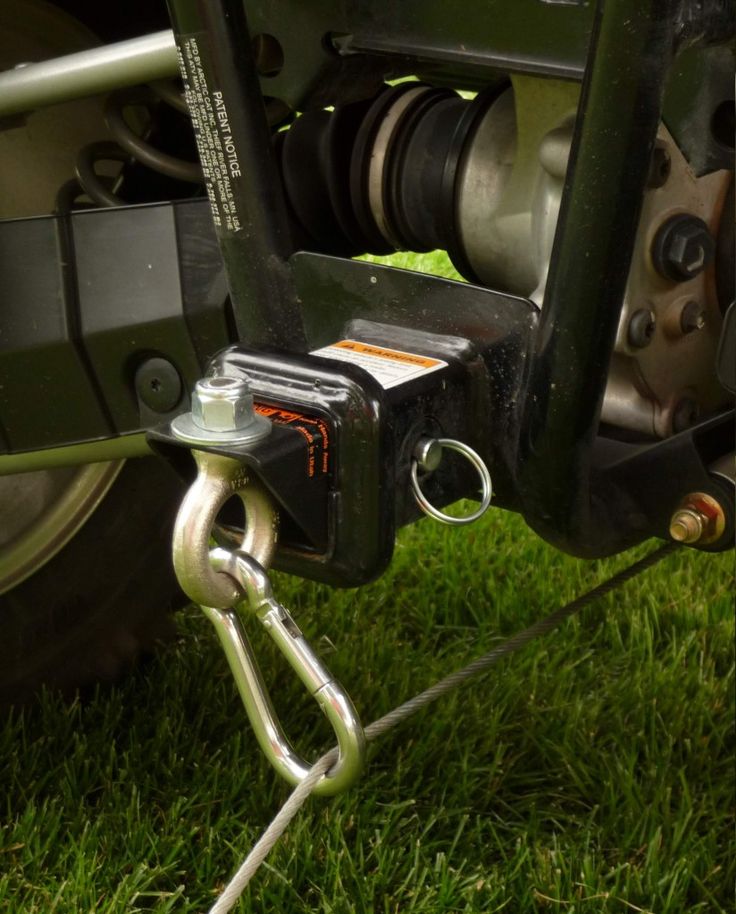 After all, this can turn out to be deplorable not only for your car, but also for those who are nearby.
After all, this can turn out to be deplorable not only for your car, but also for those who are nearby.
On some shackles you can find WLL (Working Load Limit) or SWL (Safe Working Load), which means limit workload. For example, WLL 4 3/4t is 4 whole tons and fractional ¾ tons, which is equivalent to 4.75 tons of workload. May also occur MBS (Minimum Breaking Strength), which means the minimum strength or breaking load. This parameter is usually much larger than WLL. In other words, long-term work within the WLL is safe, and its excess leads to the accumulation of fatigue deformations. And already when the MBS is reached, a high degree of probability of product destruction appears.
Perhaps, with all the main types of cables, slings, shackles and other devices managed to figure it out. There remain various rigging accessories that can also be used as, for example, a towing sling, but this is a separate topic of life hacks. In conclusion, one important point cannot be left out: going on a serious journey, you should trust trusted brands involved in the production and selling professional accessories and equipment such as redBTR .
In conclusion, one important point cannot be left out: going on a serious journey, you should trust trusted brands involved in the production and selling professional accessories and equipment such as redBTR .
Recently, the most frequent question from our customers has been something like this:
- I want to buy a towbar, a protective arc and thresholds of your production, do they need to be made as changes to the vehicle design and what will happen to me if the traffic police stop me?
Let's try to figure out if it's necessary or not?
The only document confirming the vehicle's compliance with the requirements of the technical regulations of the Customs Union (TR CU 018/2011) "On the safety of wheeled vehicles", adopted by the Decision of the Commission of the Customs Union dated 09.12.2011 No. 877 (as amended) is "Vehicle Type Approval" (hereinafter - OTTS).
After passing all the tests and checks for compliance with the requirements of TR TS 018/2011, an accredited certification body issues an OTTS for a certain make and model, this document is issued for a certain batch of vehicles indicating the VIN numbers (*********** *001 - **************999) and lists all equipment approved for installation (if not installed when sold by the manufacturer) and use on public roads without a change to vehicle structure. Simply put: everything that is inscribed in a specific OTTS is already allowed for operation on a given batch of cars.
Example: 2019 Pajero Sport III
On page No. 6 in the appendix we find the interesting list of approved equipment for this type of vehicle:
Based on the information specified in the documents above, the car (included in the lot included in the OTTS) can be used with a tow bar (TSU), side steps, lower protection of the front and rear bumpers. Naturally, the OTTS does not specify the manufacturer of these structures and it can be anything: the main condition is the presence of a certificate/declaration of conformity for the manufactured products or the presence of a document confirming that there is no need to issue a certificate/declaration of conformity.
And now, the question is: where can I get a certificate of conformity for a towbar, an arc, thresholds purchased from Pajero Shop? We answer: we do not have a certificate of conformity for products, because we do not mass-produce it, as stated in the officially issued conclusion of VNIIS:
What is the conclusion of VNIIS? - A response to a supplier or manufacturer of products about whether the product is subject to mandatory certification or declaration is also referred to as a "rejection letter".